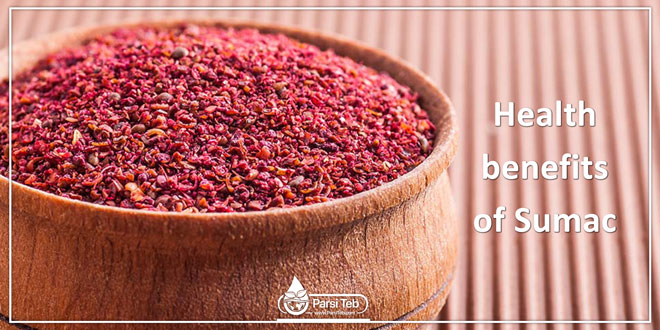Health benefits of Sumac
Sumac spice as we all now are powder of dried fruits of sumac herb or Rhus coriaria. We all enjoy recipes made from this tangy lemony red spice and is very common in Mediterranean and Middle Eastern cooking. Grilled Fish or meat marinated with ground sumac spice! Sumac is often used as substitute for lemon zest or vinegar.
It is name of flowering plant of genus Rhus. As against its cousin – poison ivy, Sumac is perfectly non poisonous and edible. Word sumac comes from old French word sumac which means red. Fruits of sumac herb form dense clusters of reddish drupes, which are also called as sumac bobs. The tangy crimson spice which is popularly used is nothing but these purple red fruits, dried and ground, often mixed with salt.
Smooth and staghorn sumac are species found in North America. Shoots of smooth one are edible and were used by native Indians in salads. In North America, Sumac is used to make tangy cool drink known as sumac-ade or Indian lemonade or rhus juice. Sumacade is made by soaking sumac drupes in cool water, recovering extract and adding sweetner. Native Americans mixed Sumac leaves and drupes along with tobacco in their smoking mixtures.
The fruits contain mainly water soluble extract containing Vitamin C and other vitamins, protein, fiber and Minerals like potassium, calcium, magnesium, phosphorus. Nearly 4% of sumac by weight includes tannins. Its tangy flavor is result of high acid content and because of malic acid citric acid, fumaric acid and ascorbic acid present in berries.
Health benefits of Sumac
It has been used across globe for its medicinal properties and uses. Research has showed that health benefits of this plant are many, some being antifungal, anti microbial, anti oxidant, anti inflammatory. Extract of Sumac and various bio active compounds which has potential health benefits and other food and industrial uses. Research is still ongoing in understanding full potential and health benefits of sumac. Sumac has been used as cure of various ailments in medieval medicine. Potential finding of sumac drupes in an 11th-century shipwreck off the coast of Rhodes, suggests its use as medicine, culinary spice or as a dye. Some of the health benefits of sumac are given below:
Anti oxidant properties
It is full of Vitamin C and other phytochemcials which are strong antioxidant in nature. They help ward of free radicals in body and thus protect body from degenerative diseases including cardiovascular diseases, stroke and diabetes. Results of lab studies on strong antioxidant properties of Rhus coriaria has been published in Journal, Phytotherapy Research and Journal of Medicinal Food.
Anti inflammatory properties
This plant and its extract have good anti-inflammatory properties. Sumac helps in reducing fever. It works great for arthritis, skin inflammation, and respiratory problems such as bronchitis, colds, and flues. Poultice made from its leaves is used to treat skin rashes. Its leaves can be chewed in case of sore throat or inflamed gums and lips.
Anti microbial properties
Sumac has anti microbial properties. A study published in International Journal of Food Microbiology suggested its antimicrobial activity that can combat Salmonella bacteria. Water mixed with sumac extract can be used to treating vegetables and fruits and get rid of bacteria on them. Anti microbial properties of this plant were attributed to presence of methyl gallic acid, gallic acid and other compounds in a study published in Journal of Ethnopharmacology. Traditionally powdered sumac bark is used as antiseptic.
Antifungal Action
A research published in German bioscience journal, Zeitschrift Fuer Naturforschung, showed that seeds are effective against Aspergillus fungus which causes lung infection and infection to other organs.
Rhus for diabetes
Research further suggests that it is effective in case hyperglycemia, diabetes and obesity. Lab results have shown that sumac with its strong antioxidant properties help reduce blood sugar and cholesterol levels.
Diuretic properties
Sumac berries have diuretic properties. It aids in production of urine and helps in excretion of toxic materials from the body. It is used to cure inflammation of the bladder and painful urination. It is often used in bowel complaints. In Middle East, sour Sumac juice is used to relieve stomach upset. Sumac berries are chewed as traditional remedy for bed wetting.
Anticancer properties
Some research is also carried on its anti tumour properties. In one study, edible staghorn sumac fruit extract, used along with chemotherapeutic drug, treated breast cancer cells while no effects on other healthy cells. Thus Sumac extract was considered promising chemotherapeutic drug conjugate in cancer chemotherapy.
Sumac for women
Traditionally infusion of sumac bark/rooks or sumac tea is used as cure for women disorders. It is externally applied in case of excessive vaginal discharge. It helps in increasing secretion of breast milk. It has estrogen like behavior and helps in treating menstrual disorder, menstrual cram
To summarize, health benefits of sumac can be mainly attributed to its anti microbial, antioxidant and anti-inflammatory properties.
This plant health supplements, Sumac health tablets/capsules providing similar health benefits of sumac are available in market. We advise our readers to consume such health supplements only with after consulting health practitioner.
Sumac plant typically belongs to sub tropical and temperate region. It grows in Mediterranian countries, North Africa, South Europe, Afghanistan and Iran. It is a popular condiment used as souring agent. This reddish purple sumac spice power is very common in Middle Eastern and Arab cooking. Sumac adds a tangy lemony taste to food. It is used to marinate meat, garnish hummus, salad. In Iran, sumac is added to rice or kebab. Mixed with rice and freshly cut onion, it is served as appetizer in Turkey and Iran. Turkish döner kebab are incomplete without sumac flavoruing. Popular Jordanian spice mixture za’atar contains sumac (Rhus coriaria) along with sesame and thyme.
Young shoots of Sumac are eaten. Once peeled, the white core inside the young shoots are either eaten raw in salads or cooked. They have strong aroma and astringent taste.
References:
http://www.parsiteb.com
valuefood.info
 Parsi Teb Physical and Mental Health Journal
Parsi Teb Physical and Mental Health Journal 


